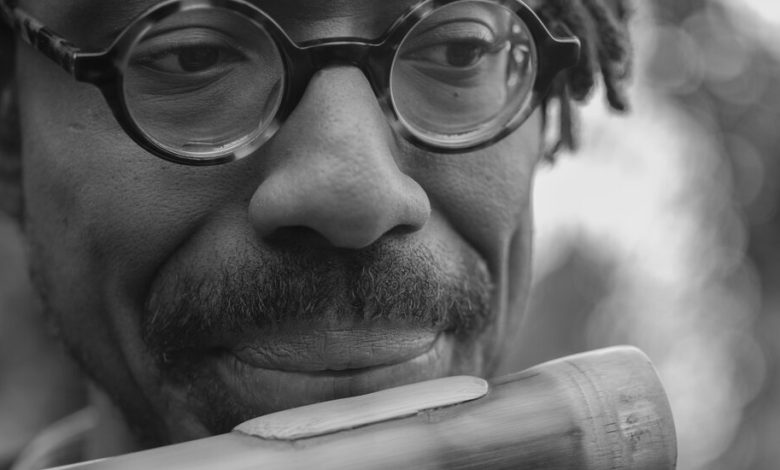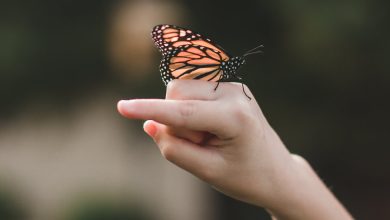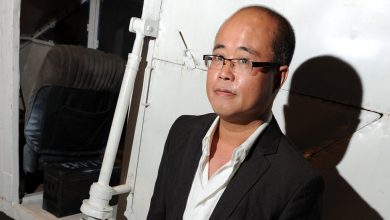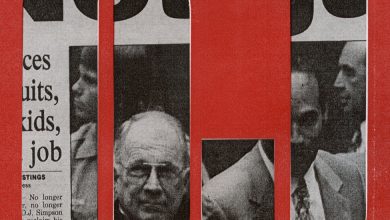The Saxophone Master Shabaka Hutchings Is on a Fresh Journey: Flutes

As Shabaka Hutchings led a concert tribute to Pharoah Sanders in early December, he returned to a familiar equation: funneling gallons of air through his tenor saxophone, transforming it into a corrosive stream of sound.
Hutchings has been an essential figure on a British jazz scene that has experienced an uptick in popularity over the past decade because of its erasure of genre boundaries and its embrace of the art form’s foundational dance music sensibilities. His distinctive tenor has long been the through line of his diverse, widely acclaimed projects, connecting the electronic skronk of the Comet Is Coming to the fire of Sons of Kemet, and lately to the legacy of fellow hard-blowing saxophonists like Sanders.
But by the time we met earlier this month, Hutchings, 39, had put down the saxophone, if not for good then certainly for the foreseeable. A handful of gigs across London last month — the Sanders tribute, an extended take on John Coltrane’s “A Love Supreme” and a final flourish as a guest with the pianist Alexander Hawkins’s trio — were the final chances to hear Hutchings performing on an instrument that has dominated his musical life for the first part of his professional career. When he appears at New York’s Winter Jazzfest as an artist in residence this week, for the most part he will be playing flutes, an instrument group that he first picked up in 2019.
“The bands that I was doing those gigs with became successful enough for them to dominate all the space of my work,” Hutchings said, speaking quietly and methodically, in a way that suggested recounting recent life events to others may be another extension of his artistic practice. “People say, because you’re doing lots of work on the saxophone, you are a saxophone player. I’m not really a saxophone player.” He felt that the only chance to be proficient elsewhere was to make a bold change.
“I think of him as a sort of a multi-instrumentalist,” said the pianist Alexander Hawkins, a longtime collaborator. “Rather than being a switch, I think this is just a move towards other modes of expression.” The decision, which Hutchings said “ultimately boils down to intuition,” still surprised even him, though. “I literally would never have imagined putting down the saxophone back in 2020,” he said.
In 2020, Hutchings also likely didn’t anticipate a rising profile for the flute in jazz. But “New Blue Sun,” a surprise release from the onetime Outkast rapper André 3000 last November that featured him playing different types of flute, gave the instrument a boost. (A new album from Hutchings is due this spring.)
“We’ve arrived at the same place in terms of wanting to play the flute, but from completely different sides of the spectrum,” said Hutchings, who performed on the album. “There’s a stage when you focus in and get quite diligent, but I think a big part of playing the flute is jamming flute stuff. That’s where I found him, that’s where he found me, and then we became flute bros.”
Hutchings’s journey with the flute began in earnest during the height of the coronavirus pandemic, when he faced a rapidly thinning calendar of tour dates. “In that space, I really connected with practice,” he said.
It was a different kind of practice: thoughtful, free and natural. Hutchings was living in Kingston, in southwest London, close to the expanses of Richmond Park. Like Sonny Rollins, who would play his sax on the Williamsburg Bridge in New York, Hutchings took his instruments into the deserted public spaces and conducted his practice under trees, in fields and inside hollowed-out tree trunks, sharing snippets with audiences on Instagram.
“Rollins’s sound became bigger, because he was blowing into the noise of New York City, whereas when you’re in nature, your sound becomes smaller, and your dynamic range in small dynamics becomes a lot larger,” Hutchings said.
The main vehicle for these adventures in smallness wasn’t the saxophone, an instrument designed to project outward, but the naturally more inward flute. Or rather, flutes, plural. Hutchings brought a tall gig bag to our interview. It contained a selection from his growing collection, and he unveiled each flute from its protective floral cloths with a sense of tactile ritual. The instruments represented a range of origins and traditions, and were all handmade, mostly out of wood. All the flutes are keyless too, allowing for minute tunings, akin to a trombone or violin.
“The making and the playing go hand in hand,” Hutchings said. He has already constructed one instrument himself and has plans to travel to Japan to harvest a bamboo crop he planted to create his next from scratch.
Hutchings acquired his first shakuhachi, a Japanese bamboo flute played vertically, while performing in Japan in 2019, but it wasn’t until the pandemic that he really had the time and head space to dedicate the necessary amount of energy toward it. “It’s an insanely difficult instrument, and the beauty is no one can actually get a sound out of it,” Hawkins said.
Even Hutchings struggled at first. (The shakuhachi embouchure requires complete relaxation to make the instrument speak, in complete contrast to the saxophone, where blowing harder — and thus tenser — is generally rewarded with more sound.) “It’s not like I picked it up and had a revelation,” Hutchings said. “Because, yeah, I really am a beginner of the shakuhachi.”
It makes sense that Hutchings, an artist whose hedonistic saxophone sound obscures a steely belief in self-discipline, has picked up this challenging instrument. (Toward the end of the interview, he said that he was in the middle of a fasting period ahead of his trip to the United States.) “Shakuhachi is not just a musical instrument,” said Katsuya Nonaka, a player and maker who is helping Hutchings make his own instruments. “It’s a lifestyle, a way to connect to nature.”
Hutchings’s first instrument was the clarinet, which he picked up at age 9. Born in London, he moved to Birmingham as an infant before relocating to his parents’ native Barbados at age 6, then returned to England as a teenager. He later studied clarinet at the Guildhall School of Music. It’s a period that he has been reflecting on a lot recently, both because of a book project — a series of life lessons for young musicians Hutchings wished he’d known when he was coming up— and because of his status as a professional turned beginner.
“I think a lot of beginners actually put themselves down, because they don’t understand how long it should take,” he said, estimating that it takes seven or eight years to learn the technical foundation to be able to even approach the Japanese shakuhachi repertoire. “So it might be that you sound terrible for a few months. You start feeling like, why am I not getting any better? As a professional, you know that you shouldn’t be getting better before at least a year, and that the process is going to be a long one.”
At the Winter Jazzfest, Hutchings will travel through myriad musical contexts, focusing on the flute in performances in a duo with Joe Lovano; with Miguel Atwood-Ferguson’s improvising string quartet; in a large group gathered to celebrate Mtume Umoja Ensemble’s album “Alkebu-Lan”; and as the main focus of an Impulse! Records showcase, backed by Esperanza Spalding and the harpists Brandee Younger and Charles Overton.
Such eclectic assignments wouldn’t surprise Hawkins. “With certain musicians, the player is completely inseparable from the instrument,” he said; someone like Sonny Rollins “doesn’t really make sense apart from on the tenor saxophone.” But Hutchings is a bit more like a Don Cherry figure, where “the person is the adventurer, not the instrument.”




